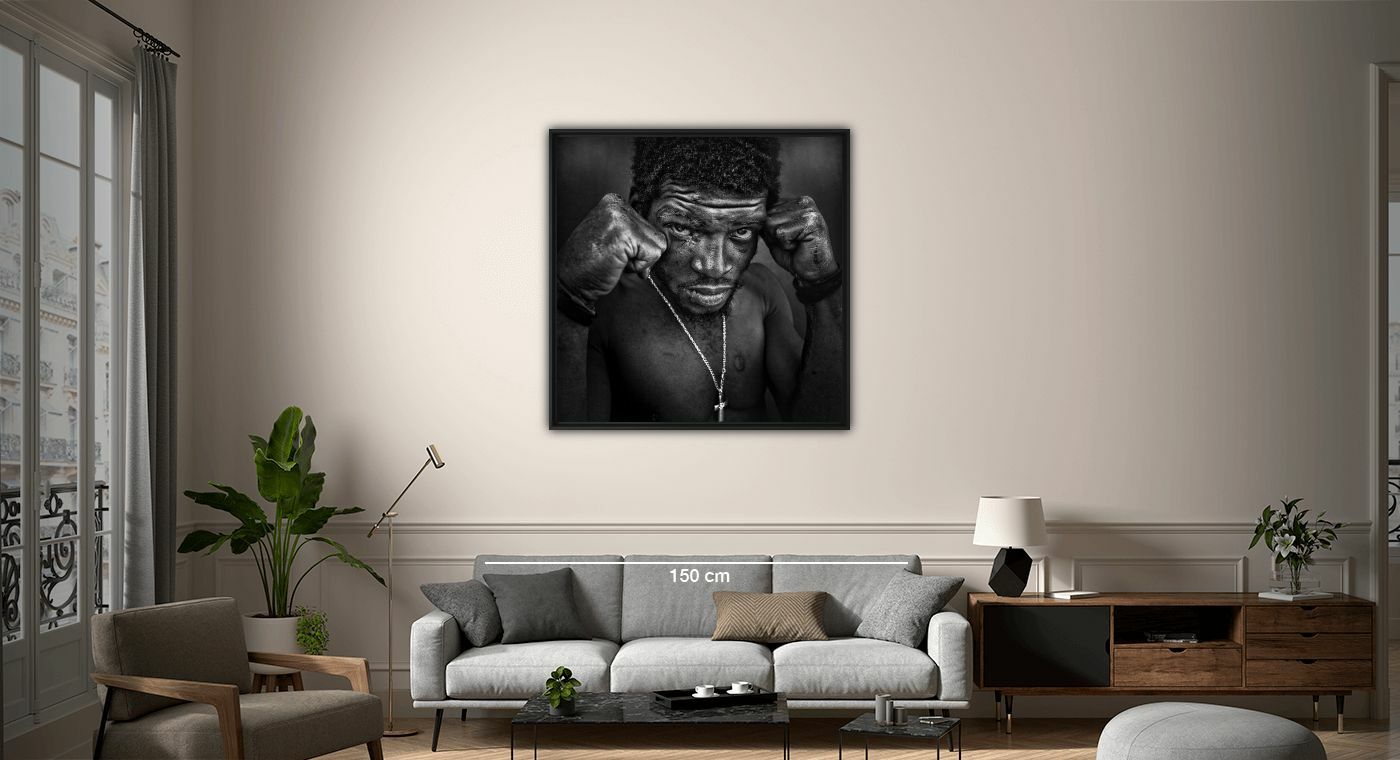How was your passion for photography born?
I'm a romantic. I’ve spent the entirety of my adult life searching for something. In my 20’s and 30’s I hadn’t a clue what that was. It was only in my 40’s, when I first picked up a camera, that I realised what I sought was in fact, love. My youth precluded the recognition of loneliness. As I’ve got older, I’ve found that loneliness that has always been there has taken more of a driving seat. Its become my inspiration. Its taught me compassion. It drives me out on the street to be with strangers as a sort of antidote to my own sense of pain. It ignites my own sense of faith and a deep curiosity of how that shapes other peoples lives. You’ll find the story of my life in my images. To emphasise, each one of my photographs is my way of saying goodbye to that relationship. I will sit and linger for hours and hours deliberating over the image. It’s a mourning period. This is actually the truth.
Any sources of inspiration among artists?
There’s a spiritual resonance in my work. I try to use light and shadow in an almost spiritual way. Whilst it’s intentional to cram into my images a religious and metaphysical interpretation, I have to say it’s probably more instinctive than deliberate. From the beginning of the process I enter an ethereal journey with my subject. I feel their loneliness, despair and pain. More often than not, and whilst it may sound pretentious, I will find myself in tears for them. My images represent my final goodbye to a relationship built on authenticity. I’m attracted to the work of others who are able to convey this too. I’ve long admired James Nachtwey and Stephan Vanfleeteran for example.
What encouraged you to immortalise the homeless?
Its truly ‘personal’ ……‘a bit of a long story’, but more accurately it’s rather like the ones most people are not actually prepared to tell. I see myself as a lonely individual and my ‘Lost Angels’ work is for the large part an antidote to this engrained feeling. I’m from Manchester, but the majority of my work has been done in the usa…..the real reason, as some might guess, lies with a relationship rather than amongst the more commonly recounted tale of getting sidetracked when I was supposed to be thinking about running the London Marathon (I’ll revisit that aspect later): The real reason is that I met someone, ten years ago now. She was a photographer and her influence over a series of events has continually washed over me. She lived in the US and the biggest thing to recount was that her mother, a devout Catholic, was diagnosed with cancer and I ended up going to Rome to get her Rosary reblessed in the Vatican and then get it back to her before she died. My feelings around love and death, her compassion for the homeless, amongst that experience in Rome have the biggest influence on my pictures now.’ And now I can return to the London story: The first time I made an “approach” to get such a “homeless” picture was in London –I was going to run the marathon on the Sunday and the day before I thought I’d try my hand at a bit of street photography… I started shooting from across the street and the girl kicked off at me. It was the other people around that created my deep embarrassment – I felt the whole world judging me on what I was doing and rightly so – I didn’t know what to do.’ I’m not the give-up-and-run type: I went over and started talking to her. I was shamed into approaching directly and properly I suppose you could say. Everyday people have a couple of possible reactions to the homeless – look the other way and try not to think anything about it, or fear. After I had spent five minutes with the girl I realised it was this level of intimacy that was required – not anything about the picture, the picture has become the last piece of the jigsaw, it is the closing of the relationship.
What would you like to photograph for your next series?
I always say to people, when I find that love, that sense of belonging, maybe my photographic journey will end. I’m still searching. 2018 will see me continue the homeless project” in San Francisco. I’ll be there for three weeks. I have further exhibits in Orleans, Naples, Seattle & Perugia. In conjunction with a French organisation, I am involved in a book project which will consist of over 350 Rugby portraits in time for the 2019 World Cup and most excitingly my images will feature extensively in this summers blockbuster movie staring JLo, Second Act.
Any anecdotes about your YellowKorner photographs?
If I had to describe my “method” I would sum it up with one word. “Chance” Nobody I meet is predetermined. For example. Margo. A person I met in Miamo. I looked up and there she was. Stood before me, as we later joked in "full hooker mode". Fur coat, high heels.....smeared lipstick. We developed quite a bond over the few weeks that followed. I guess I fell in love in a strange kind of way. Her youthful beauty twinkled beneath the facade of years on the street. Her life "before" hit me hard. I'll never get over how helpless I felt. I wanted to turn back time to when she was just a girl. I felt, and still feel I could have saved her. Then again can you really save somebody from themselves. On leaving that final day I shouted from the car as she walked away...."Margo. You're beautiful"...She stopped, turned to face me and replied "so are you"......... One of the new images to be carried by YellowKorner is “that moment….just before”. (attached to this email Carole) I was out wandering the streets of Manchester. Looking, as I do, intently into the eyes of strangers. I happened to come across an elderly couple walking from a supermarket. The vision of them immediately took my mind back to my own grandparents. How “she” would lead him around town and how he would dutifully follow her. The love my grandparents shared was born in world war 2 and lasted a lifetime. I saw the same love shared by this couple on the street. To all intents and purposes these strangers represented something deeply personal and I was able to capture such intimacy and love in the final photograph because it was something I truly felt. To love and to be loved. This image is the perfect representation of just that.
How do you choose the subjects for your photographs?
For me, image making is a way of being. I’m wandering with an open heart and a genuine sense of wonderment—through dark and light places alike. I guess I’m searching for divinity within the purest of human emotion. It’s a way of seeing with my heart. Feeling. I photograph people from a variety of social demographics. There is a common thread thoughout. I have to have felt something way before I ever photograph them. I can walk the streets for hours in search of that instant recognition of emotion in a strangers eyes. You can’t teach it . . . it’s instinctive. Spontaneity borne from my own pain and loneliness? We should leave all that phycological babble to the experts perhaps . . . as a “photographer”. . . I’m content enough in that ability to simply trust it.
Why have you chosen only to photograph in black and white? Are you considering taking colour photographs?
There are more colour images coming into my portfolio. I guess black and white has always resonated from my early experience with those World War 1 images. I’ve begun to explore colour in more depth so expect to see much more of them.
What was your encounter with the director Terence Malik like? What did that contribute to your work?
I was in Miami, on one of my homeless projects when Terrence contacted me. He asked if I would be interested in helping him collect footage for an upcoming movie “The Voyage of Time”. Of course, I was elated to be asked. His work has had an incredible influence over me. He seems to have the same sensibility and examines humanness in terms of a higher influence. I agreed to complete the project and he duly sent me a small video camera to capture this footage (youll see Ben Afleck using the very same camera on the Eurostar scene of the movie “to the wonder”) Over the course of a year, I’d go out, with the camera and document stuff out on the street. I was delighted when he actually used 5 pieces of that work in the final presentation.
Did starting to work with Nick Cave launch the start of a new creative period of celebrity?
I have been a huge fan of Nick for many years. In fact when I’m processing an image I’m often listening, absorbing Nicks Ballards. To get the chance to meet him, photograph him, was a dream come true. He invited me to come over to his soundcheck prior to his Manchester concert last year. I sat there almost alone at the MEN Arena and just watched him in amazement. It was like he was singing just for me. The experience was truly astonishing. I guess I am open to portraying homeless, street or celebrity so long as I “feel” the person. There has to be that connection. I got the change to photograph Torie Campbell (a British TV presenter) and Gin Wigmore (New Zealand song artist) and both experiences were incredibly positive. Never say never….so if more celebrity portraits are in my future I will not be complaining.
What famous photographs made an impression on you? And which ones do you like at YellowKorner?
The photographs that I guess have had the biggest impact on me were actually when I was at school. Viewing images of world war 1 soldiers hit me hard. Something about their eyes and how incredibly that was married with spirituality and even death resonated strongly. In terms of the images YellowKorner carry, I would have to say I have always loved the work of the Formento’s. I remember talking with BJ some years ago. I’d noticed an image of his, which is now known as the “smoking nun” It wasn’t carried by YellowKorner then but I had seen it on his website. It was simply beautiful so I asked him for a copy. A few months later YK had the image and the rest is history. It went on to be incredibly popular throughout the YK chain of galleries. I’m still waiting for my copy BJ?!!







